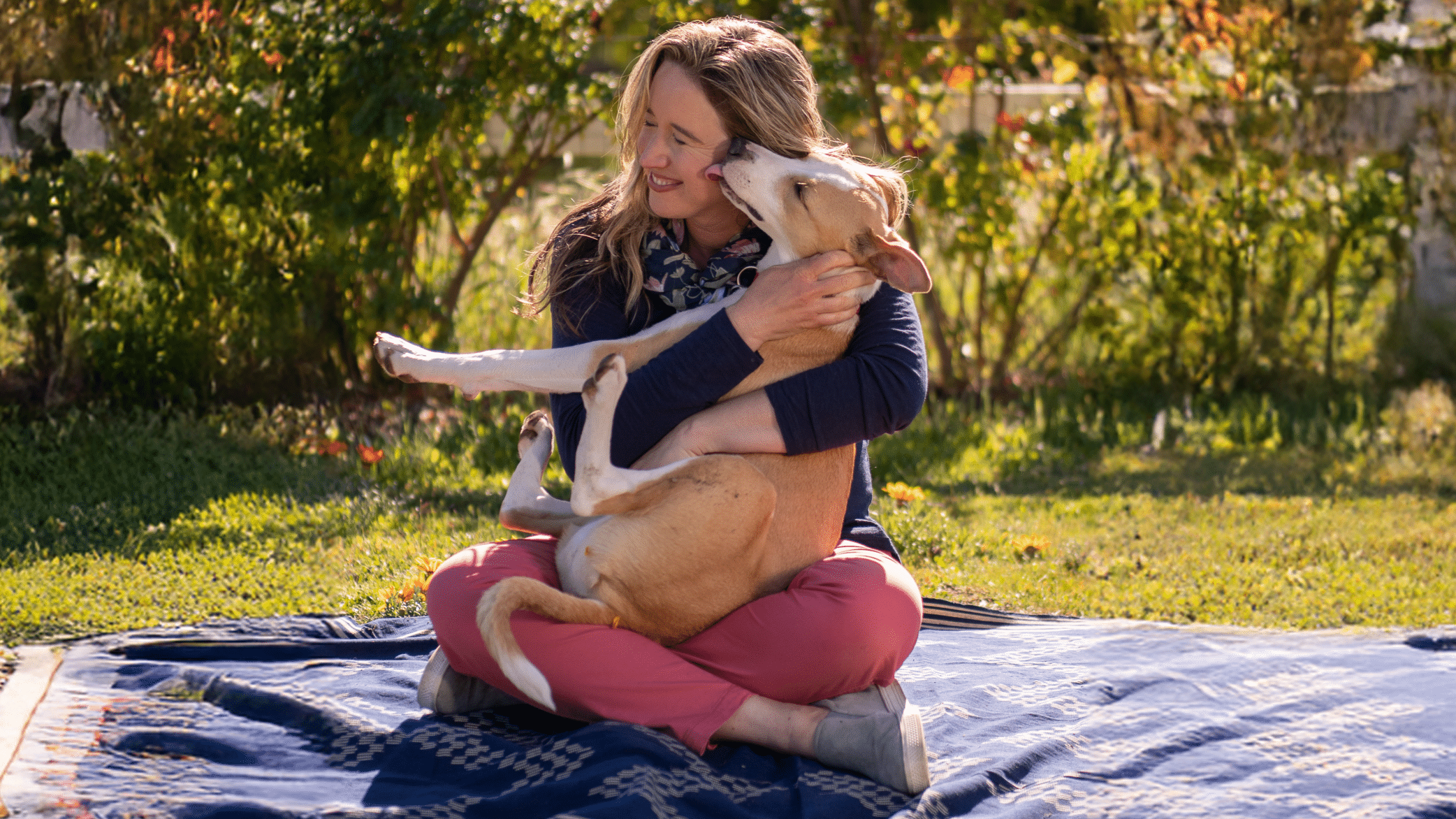
There was a brief period back in 2006 where I had only one pet. Sandy was a conversation starter of a dog. She was a 25 pound dachshund mix, who considered her back foot a threat, regularly growling at it, sometimes barking at it, chasing it, occasionally catching it. Certainly startling to guests. Or at 2 am when she’s under our bed.
Now I have five pets: two dogs (Sadie and Layla) and three cats (Ollie, Ginny, and Mookie). All rescues. All very opinionated. All have kept me company while I work from home, supervised me, and given me much practice cleaning a wide variety of grime and mess on a wide variety of surfaces. And now I’m going to put all that experience to good use by sharing it with you!
Over the years I’ve written several times about caring for our furry, feathered, or scaled friends using Dr. Bronner’s Castile Magic Soap & Sal Suds Biodegradable Cleaner. One of my favorites, Dog Washing with Dr. Bronner’s Soap, featured Tucker, my noseless black labrador. Then, a few years later GIY Pet Wipes with Dr. Bronner’s Pure-Castile Soap introduced you all to Sadie, my one-ear-up-pup. Considering how often my day is interrupted by pet situations of one sort or another, I’m bursting with more tips.
This article will cover in brief all the many aspects of caring for and cleaning up after our pets. For deeper dives, looks for the links to whole articles on each topic.
Table of contents:
- Introduction to My Furry Housemates
- Washing Pets with Dr. Bronner’s
- Using & Making GIY Pet Wipes
- FAQs for Bathing Pets with Dr. Bronner’s
- Washing Pet Gear with Dr. Bronner’s
- Cleaning up after Pee, Poop, and Puke
- Dealing with Pet Hair
- Cleaning Glass
- GIY “No Chew” Spray
Let me introduce you to my furry housemates
I figure meeting my pets is the best way to share my qualifications for advising on this topic.
Tucker’s gotcha story
The aforementioned Sandy wasn’t super with kids, being too consumed with the epic battle against her back foot, so we adopted Tucker, whom I met when his rescued litter was brought into my vet. As with most labradors, Tucker had a heart of gold, whose greatest joy was to be by our side. When he was 8, he had a small carcinoma in his nose. The vet removed both, and he lived happily another six years. When he was 12 and slowing down, the vet recommended we get him a puppy friend to help him stay active. Enter Sadie.
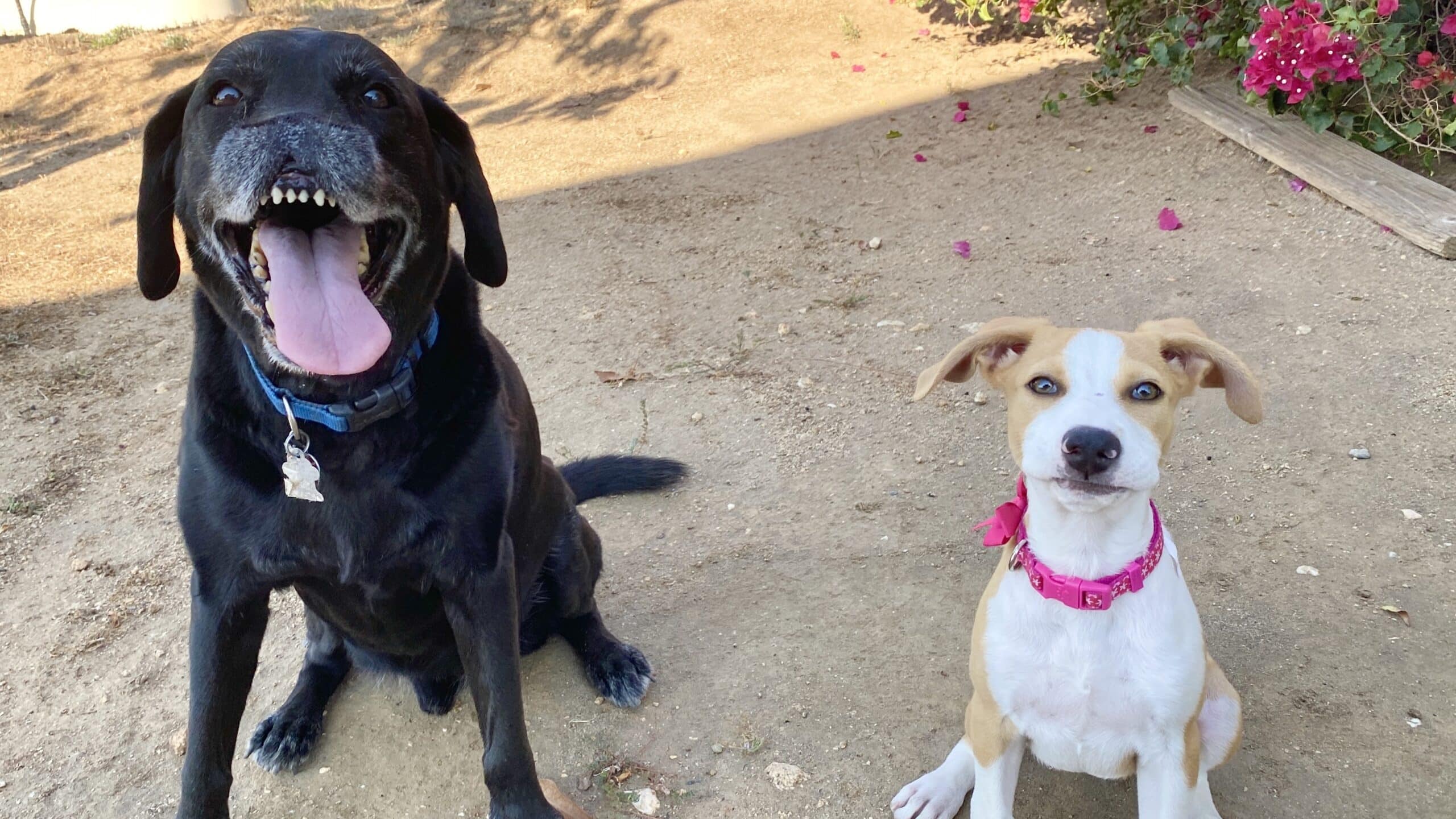
Sadie’s gotcha story
Sadie was rescued from a junkyard with her two sisters. Underfed and scrappy, she had sustained herself and her sisters by eating anything bearing a passing resemblance to food. When we weren’t looking, she’d eat snails, dead birds, napkins, and paper. She grew into a sassy and opinionated dog whose eyes speak volumes. She observes a strict bedtime of 8:30 pm and only with great reluctance will rise in the morning before 7:00. About 8 months after we adopted her, her left ear popped up. Just the left.
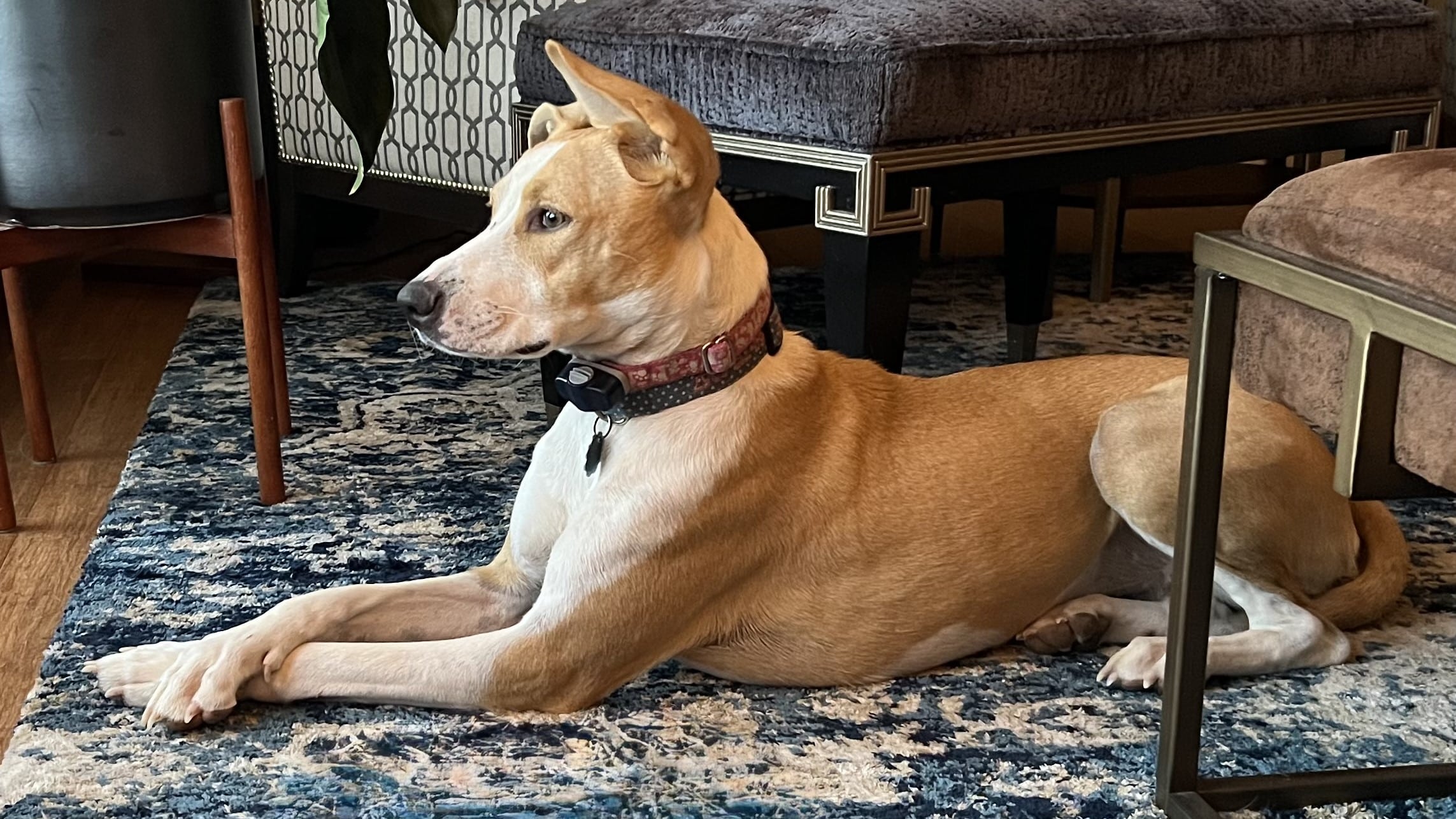
Layla’s gotcha story
After Tucker crossed the rainbow bridge, Sadie was very lonely. Although we had puppy playdates for her, when her friends went home, she’d mope and cry. So we took her to a local rescue organization and let her pick out a friend. Her attachment to Layla was instant and mutual. They are the best of friends. Layla was rescued from a sad situation in the desert and is still quite shy with strangers. As of this writing, she is a year and a half, so is still growing up.
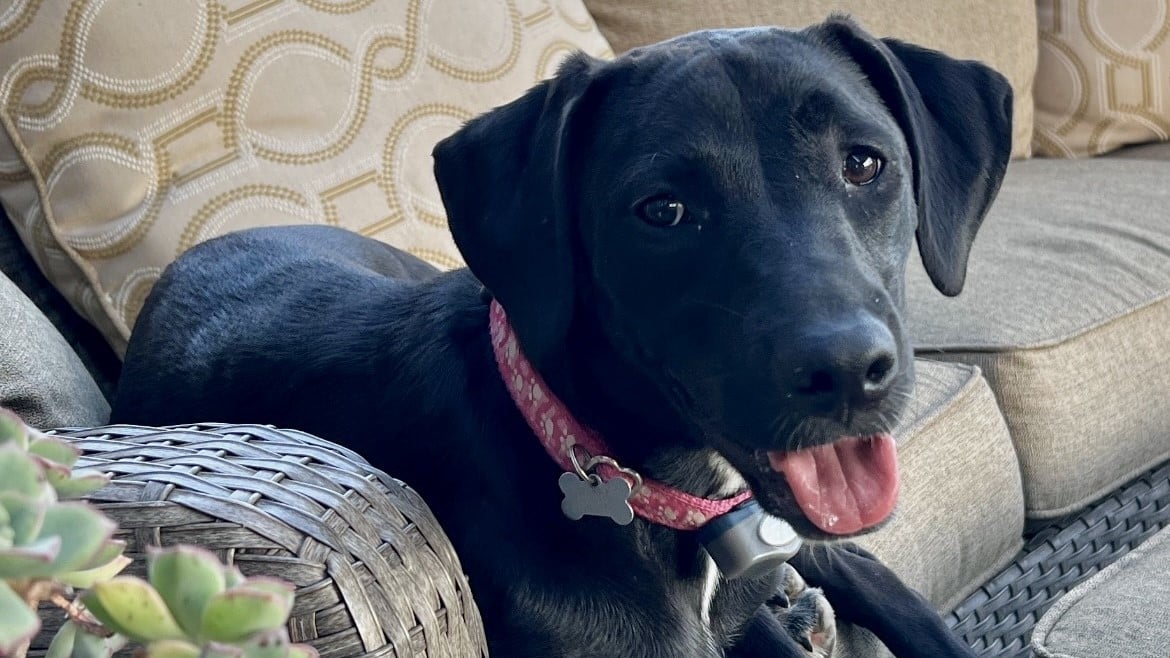
Ollie & Ginny’s gotcha story
We wanted a bonded pair of cats who would be content with each other and not interested in the great outdoors. My husband Michael stopped by the Humane Society and this pair had just come in. They hadn’t been evaluated yet and needed paperwork, so Michael couldn’t adopt them that day. The next day, I was at the Humane Society before it opened so I could be first to bring these two home. They are named after two of the cats in the James Herriot All Creatures Great & Small stories. Ginny mostly gets called Pookie because of her timidity, except when it comes to letting Mookie know who’s boss.
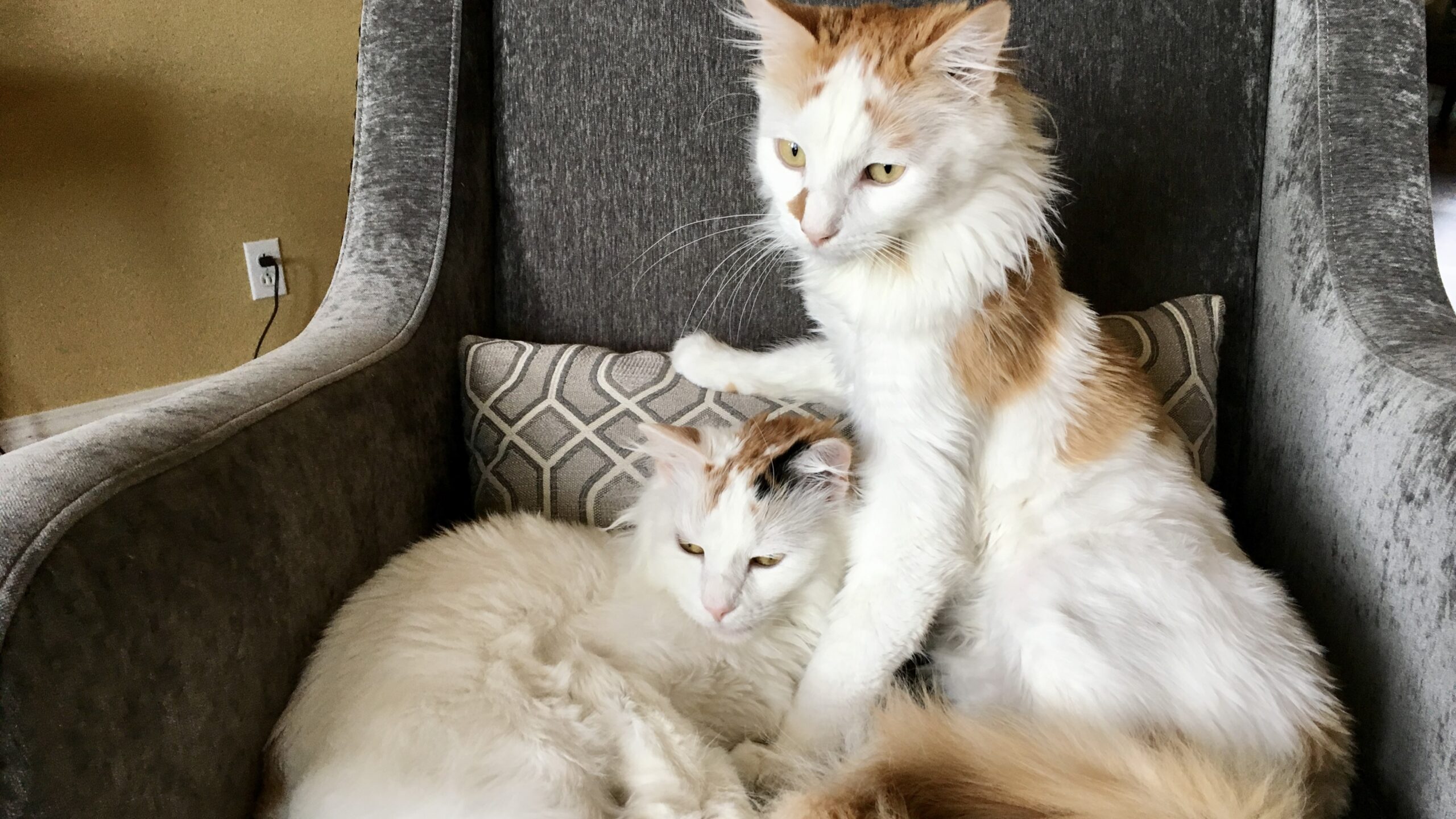
Mookie’s gotcha story
One day while I was working in my home office, I looked out the window onto our front porch, and noticed a little kitty snoozing on the couch. She’d skitter away anytime we’d try to approach her, but we left food and water out for her. After this went on for several months, I wanted to get her fixed so we didn’t end up with a bunch more kittens. By this point, she’d let us touch her, though she wasn’t thrilled with being held. But once she’d had her procedure and spent the week recovering in a bathroom, she realized that indoors is a pretty great place to be. The three cats have split up the house into their territories, and for the most part peace reigns. If ever the cats get spicy with each other, the dogs eagerly run over to check out what’s happening, effectively breaking up any altercation. The dogs are ever hopeful that the cats will want to play with them. Hasn’t happened so far.
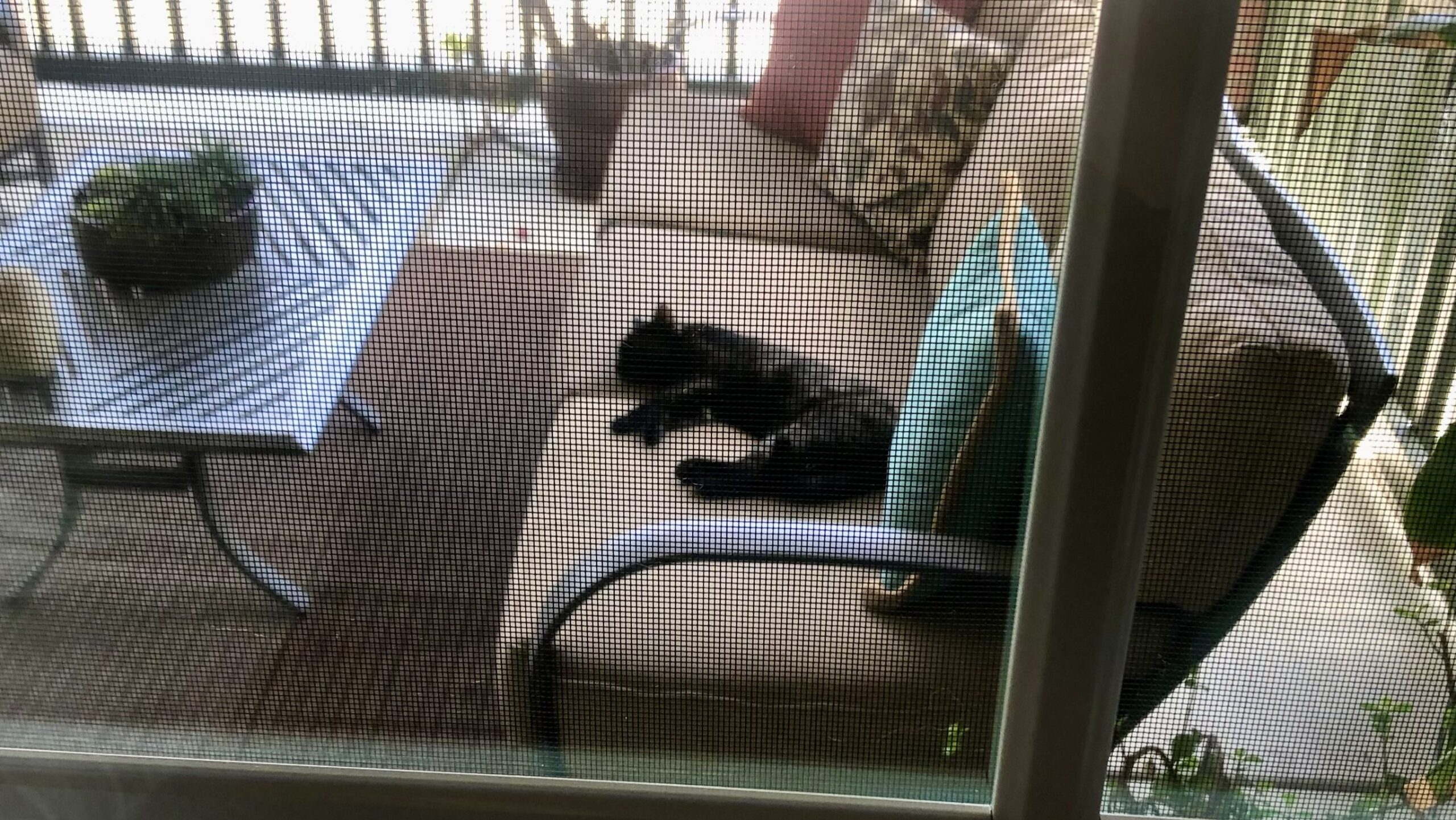
Washing pets with Dr. Bronner’s
The simplicity that makes Dr. Bronner’s Pure-Castile Magic Soap great for our bodies also makes it great for pets. The nourishing blend of organic coconut, palm, olive, hemp seed, and jojoba oils cleans gently and thoroughly. No junk. No fillers. No residues. No artificial fragrances.
For a fantastic overview of washing all manner of pets, I highly recommend Using Dr. Bronner’s as Pet Shampoo for Dogs, Cats & More! over on the Dr. Bronner’s website. This covers a broader range of pet types than I have experience with.
How I wash my dogs with Dr. Bronner’s Soap
I’ve never owned an animal more exotic than dogs and cats, so that’s the expertise I can share personally. Both for your information and your entertainment, you’ll want to watch this video featuring Tucker, which shows my technique using the Magic Soap. Plus, Tucker is such an awesome show-stopper that even if you have no dogs to wash, he’ll totally brighten your day!
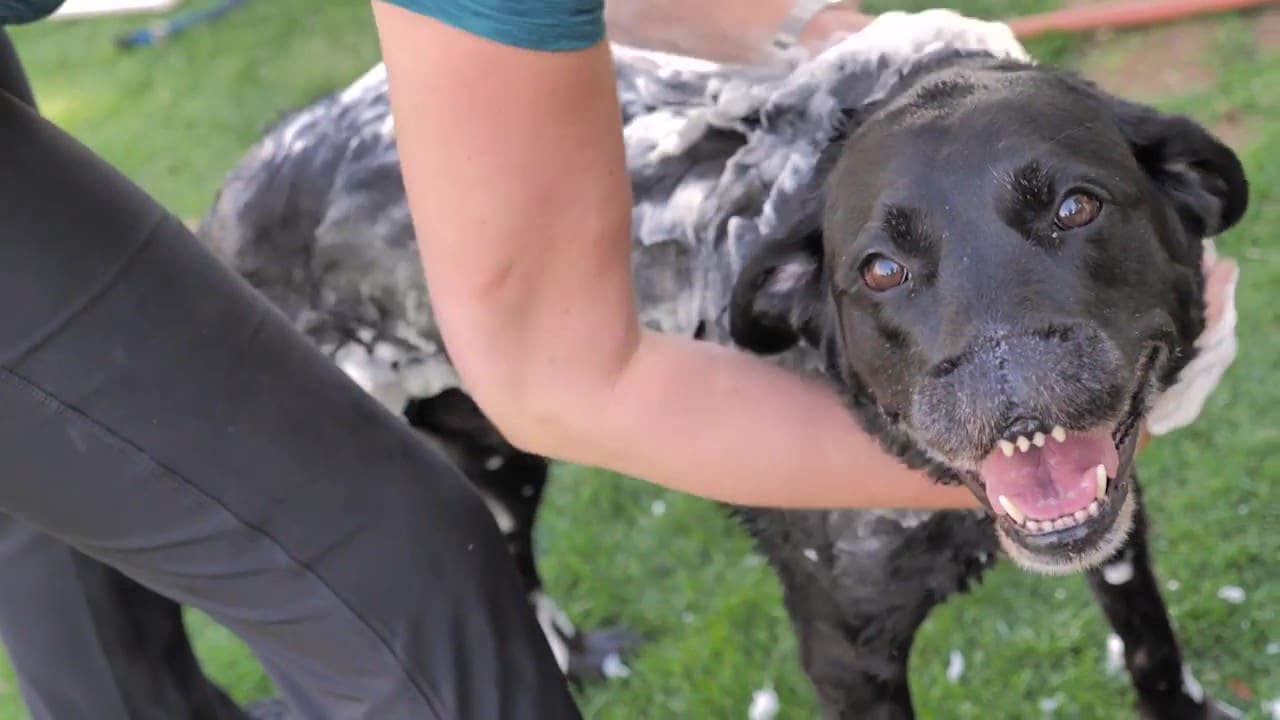
My dog-washing technique in summary:
1. Wet the dog thoroughly. Make sure their coat is fully saturated so that the soap will easily lather.
2. Apply Liquid or Magic Bar Soap directly onto the fur. I usually skip pre-diluting the liquid soap here. With the dog already wet, a small squirt goes a long way in creating a rich lather. The amount of soap needed depends on your dog’s size, fur type and thickness, and just how adventurous they’ve been. The bar soap is a super option for smaller dogs.
3. Work the soap into a lather. This is where you find out exactly how dirty they are and how thick their coats are!
4. Massage the suds into their coat. My dogs love this part! Take care to avoid the eyes and ears. As with any true soap, the Magic Soap is not tear-free. Also take care that they don’t lick or ingest any of the soap.
5. Rinse thoroughly. Any soap left on the dog actually attracts more dirt and can cause irritation.
6. Shake it off! I usually let my dog do their signature shake (especially if you’re already outside), then I follow up with a big fluffy towel to finish the drying process. This is my dogs’ absolute favorite part.
Bonus Dog-Washing Tip: If your dog is reluctant to get near the water or insists on trying to eat the soap, smear a bit of peanut butter on the shower or tub wall during bath time. It’s a great incentive and distraction!
Bathing cats and dogs with GIY Pet Wipes
I haven’t had the best experiences bathing cats in a similar manner to dogs—certainly nothing I would put forward as a technique worth following—but after mulling over several suggestions from readers (Yes! You!), I came up with this recipe for GIY (Green-It-Yourself) Pet Wipes that has been super helpful. My cats think they’re simply getting a full body rub down, and Sadie in particular acts like she’s at the spa.
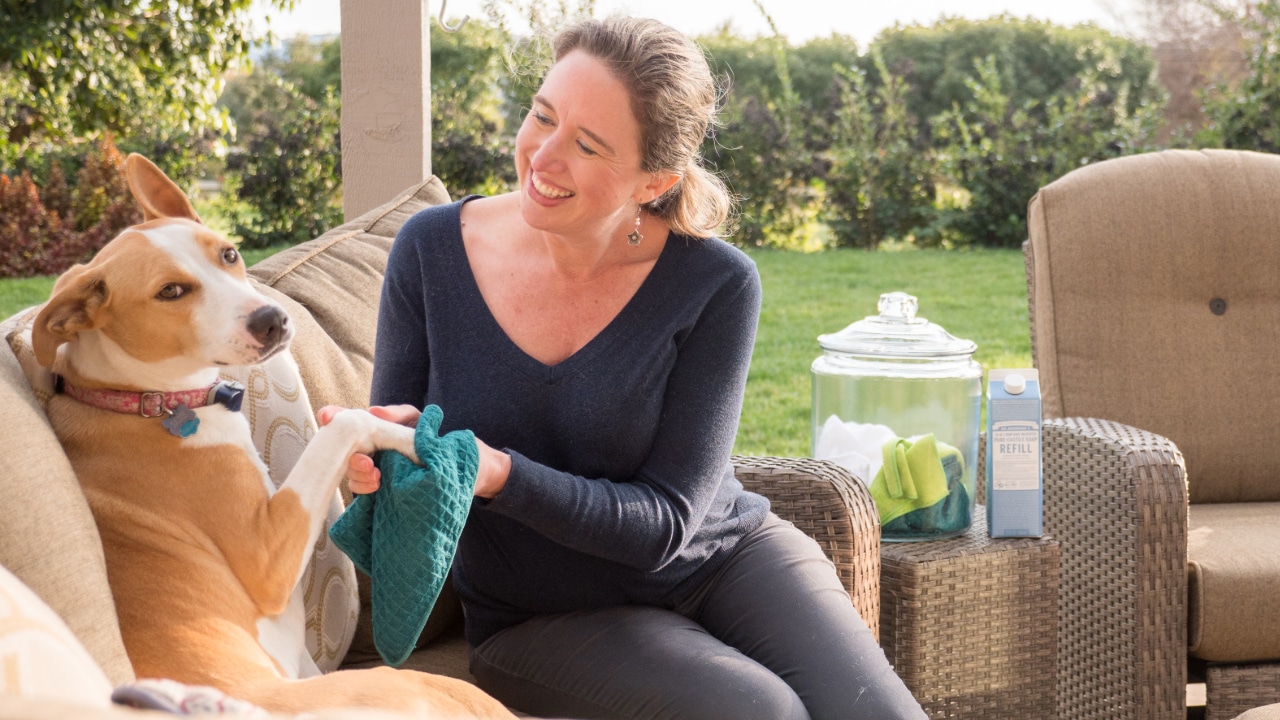
These wipes are simple to make, inexpensive, reusable, and use just a few nourishing ingredients.
What can you use these pet wipes for?
- Wiping off wet or muddy paws.
- Removing dust, dander, and allergens from fur that can irritate pets.
- Refreshing between baths.
- Gently removing tear stains. (Take care not to get soapy solution in eyes.)
- Wiping skin and facial folds.
- Bathing pets with aversion to bathing or with mobility issues.
- Cleaning backsides that catch potty business.
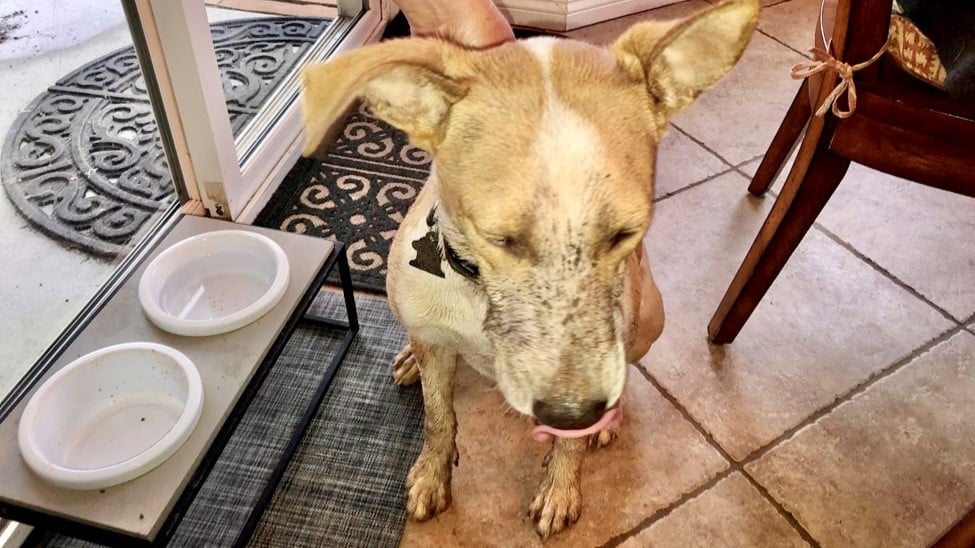
How to make GIY Pet Wipes:
- In a small mason jar, combine 1 Tbsp. (15 mL) Dr. Bronner’s Unscented Pure-Castile Magic Soap, with 1 c. (360 mL) distilled or purified water.
- Place clean wipes (washcloths, rags, cut up t-shirts, or for disposable wipes, a role of paper towels cut in half) in a water-tight container.
- Pour solution over wipes and let sit until wipes absorb the solution.
To use, wipe area with care to keep soap out of eyes. If any soapiness remains, wipe again with cloth dipped in plain water.
Which Dr. Bronner’s soap scent is best for pets?
Dr. Bronner’s uses only essential oils for scent across all product lines, so there’s no concern with potentially disruptive ingredients from artificial fragrances. However, many people have rightly thought to ask me about the potency of essential oils. For the most part, the essential oils don’t pose a problem because they are diluted in the soap, and since soap is a wash-off product, they are not in contact with the skin for very long. This means that you can choose nearly any scent for your pet bathing, with two caveats. First, tea tree essential oil is not recommended for pets in any context, so save that one for yourself. Second, cats are particularly sensitive to essential oils so use only the Unscented Castile Magic Soap on them.
FAQs for pet bathing with Dr. Bronner’s
After using Castile Magic Soap as a pet wash, would I need a conditioner?
My two pups are both short-haired, and I don’t use a conditioner. But if your pet’s coat is luxuriously long, it may need some extra smoothing or detangling. After rinsing out the soap, you could dilute a bit of apple cider vinegar in water and pour that over the coat, avoiding the face and ears. Then rinse off.
How do I clean my pets’ face and ears?
The GIY Pet Wipes are a perfect use for this, taking care to avoid the eyes. Rinse off by wiping the area again with a cloth dipped in plain water. Repeat this process on the exterior of your dog’s ears, avoiding getting water into the ears. Check with your vet for instruction on cleaning the inside of the ears.
Does Castile Magic Soap remove fleas?
While the Castile Magic Soap will wash off fleas and other insects during bathing, it does not have repellent properties and would not provide long-term protection. Check with your vet for the best long-term protection.
My pet has sensitive skin. Which scent would be best to use?
The baby Unscented Magic Soap is our most gentle formula. It’s best for sensitive skin and allergies.
Can I wash my pet with the Dr. Bronner’s Organic Sugar Soap?
The Organic Sugar Soap is fine to use on dogs. Because it’s formulated with sugar and grape juice, pups will try to lick it off though, which isn’t good for tummies. If you haven’t already given the Unscented Castile Magic Soap a try, it is the gentlest on sensitive skin.
Washing pet gear with Dr. Bronner’s
The items our pets wear, play with, eat out of, groom with, hang out in, and sleep on need their share of maintenance as well. There are four go-to GIY methods I have for cleaning pet gear:
- GIY All-Purpose spray: Combine 1 ½ tsp. (7.5 mL) Sal Suds OR 2 Tbsp. (30 mL) Dr. Bronner’s Magic Soap in 16 oz. (500 mL) distilled or purified water in a spray bottle.
- Machine laundering: 3–4 Tbsp. (40–60 mL) Castile Magic Soap OR 1–1½ Tbsp. (15–22 mL) Sal Suds for a large load in an HE machine. Optional boosters: ¼ c. baking soda added to drum, ½ c. vinegar added to fabric softener compartment. Double all amounts for standard washers.
- Hand laundering: A capful of Castile Magic Soap or a half a capful of Sal Suds in a bowl, bucket, or small sink of warm water.
- Bucket of suds: Fill bucket with water. Add ½ Tbsp. (7 mL) Sal Suds. This could be done in a sink instead of a bucket, if more convenient.
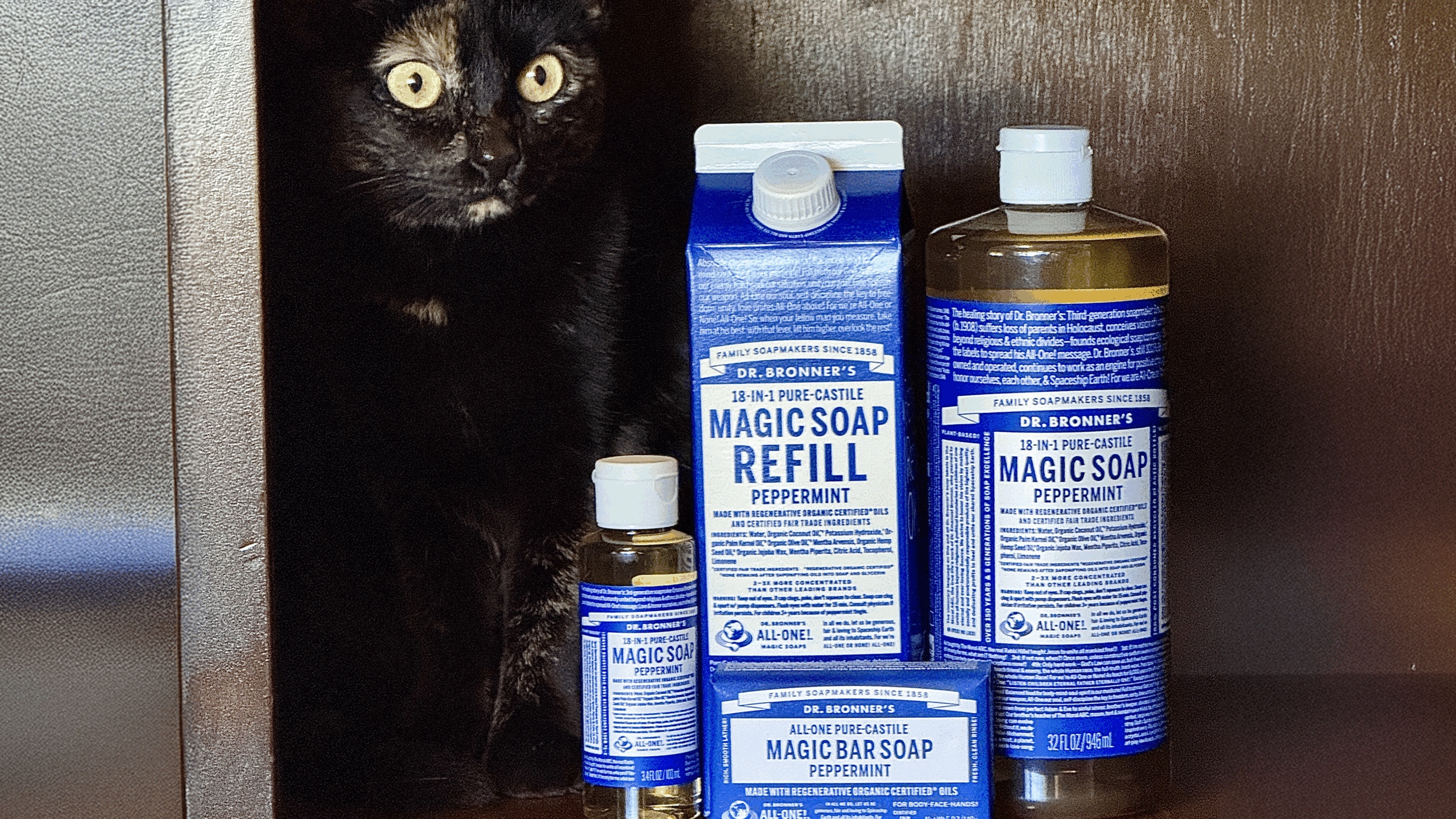
Collars, leashes, harnesses, and vests
Handwash these items in a bucket of suds. Soak the item if it’s particularly dirty and give it a good scrub with a stiff brush. Rinse well, and lay out to dry before re-introducing it to your pet.
If you’d prefer to use a washing machine, put the items that could tangle into a mesh bag. Don’t add fabric softener as that will coat the item, cause them to get dirty quickly, and introduces unneeded additional scent exposure.
For leather items, clean with a cloth dipped into very diluted Sal Suds or Magic Soap. Wipe off with another damp cloth. Never soak or submerge leather in water.
Bedding
Regularly vacuum bedding to pick up pet hair and reduce the need for a full washing.
When the time comes for a full washing, follow the manufacturer’s instructions on the tag. Many fabric pet beds have zip-off covers. Toss the cover in the washer using the machine laundering instructions above. If the bed has built up grime, use the recommended boosters, and set the washer to soak for a bit before the wash cycle.
Elevated pet beds that are not upholstered can be washed by spraying with the GIY All-Purpose Spray and wiping with a damp cloth.
Hard pet toys
In my house, it’s not uncommon to find hard pet toys in my dishwasher. Easy and done. Check the manufacturer’s instructions to see if this is possible. For toys that need to be handwashed, use the bucket of suds. If toys are really grimy, let them sit in the water for ten minutes before giving them a scrub with a moderately stiff brush, rinsing them, and laying them out to dry.
Soft pet toys
Examine the label or manufacturer’s website to see if it is machine washable. If so, toss them into your next load. If the item can be only surface cleaned, dip a cloth or brush in a bucket of suds. Wring or shake off excess solution and wipe the toys. Rinse with a clean wet cloth and let air dry.
Food & water bowls
Metal and ceramic pet bowls can usually be run through the dishwasher, although refer to the manufacturer’s label if you’re unsure. Items can also be handwashed with either Castile Magic Soap or Sal Suds. Put a few drops on a wet brush, scrub, rinse clean, and dry.
Brushes & combs
Remove all fur, feathers, or other accumulation. Wash with warm water and a few drops of Sal Suds or Castile Magic Soap. A moderately stiff cleaning brush can help clean between comb teeth and brush bristles. Rinse and let dry. Because some brushes use glue, it is best not to soak them in soapy water.
I also clean the guards of my cats’ electric trimmer with a few drops of Sal Suds in warm water.
Enclosures, gates, and kennels

While cleaning your pet’s personal space, it might be best to relocate your friend temporarily so they are not impacted or in the way. Depending on the size of the enclosure, use either your GIY All-Purpose Spray to spray and wipe, or for larger spaces, make up a bucket of suds. Dunk in your cloth and wipe down. My colleague James cleans his parrot Arlo’s enclosure with the GIY Spray made with the Unscented Magic Soap, while another co-worker Jess opts for the Sal Suds for the enclosure of Phoenix and Orian, her bearded dragons.
Cleaning up pet pee, poop, and puke
I thought about using a euphemism for this section. Pet waste. Pet emissions. But really? When you’re faced with one of these situations, you’re not looking for polite expressions. You need solutions.
With five animals in the house, we face an unfortunate frequency of pee, poop, and puke. Our household policy is, “Finders, cleaners.” Whoever comes across the mess first needs to clean it. It relies on honesty, but everyone’s a pretty good sport about it, and the system works.
First steps in cleaning pet messes
The primary principle with cleaning any of the above is to get to it as soon as possible. Procrastinating on this one definitely makes things worse. Puke, poop, and pee are all much easier to clean up if they haven’t dried.
The first thing to do, regardless of the surface, is to remove any solid matter. Whether it’s a hairball on a bed or a pile on the floor, do your best to scoop it up without driving any of it further into the surface.
Second, absorb any surplus liquid. Lay cloths over the wetness to soak it up. If you’re lucky enough that the spot is on a hard surface (yes, unlikely, but we can hope), you can absorb most of the liquid easily this way. If the wetness is on carpet or large upholstery, lay absorbent cloths over the spot and then apply pressure. I use microfiber cloths for this, since they absorb seven times their weight, and then while wearing shoes, I step on the wet area so that the microfiber draws the wetness out of the carpet. I repeat this with fresh dry cloths until I’m not pulling any more moisture out of the surface.
Cleaning pet messes off of hard surfaces
If you are so fortunate to have had your pet let loose on your tile, hardwood, vinyl, or other impervious surface, lucky you. This is so much easier to clean. After you’ve removed the solid waste and absorbed excess liquid, spray the area with the GIY All Purpose Spray. Let sit for a few minutes. Wipe with a damp cloth. If the surface is still bubbly, wipe again with a second damp cloth. Let air dry.
Sometimes the mess covers a larger area of hard flooring. I’m thinking of this past Sunday when apparently my dog goofed off when she should have been doing her business outside before I left. I came home to a small lake of pee on my tiled foyer. After soaking up the pee with beach towels, this called for a fuller mopping. I’m a bucket mopper, but another great option is a squirt bottle.
- Bucket: 1 gallon (4 L) water with 2 ½ Tbsp. (37.5 mL) Pure-Castile Magic Soap OR 1 tsp. (5 mL) Sal Suds
- Squirt bottle (like a repurposed Dr. Bronner’s 32 oz. bottle or a water bottle with a push/pull lid): 1 quart (1 L) water with 2 tsp. (10 mL) Castile Magic Soap OR 1/8 tsp. (.6 mL) Sal Suds
Submerge the mophead and wring out until damp, or squirt from the squirt bottle onto the floor and use a damp mop. With this dilution, no rinsing should be necessary.
Cleaning pet messes off of carpets:
After removing the solid matter and soaking up the liquid, spray the area thoroughly with the GIY All Purpose Spray. Using a wet, but not dripping, cloth, scrub the area well. Be sure to get into the texture of the carpet to clean the fibers from all sides. Then use a clean wet cloth to rinse the fabric. Dry the carpet by laying clean, dry microfiber cloths over the wet area and standing on it, while wearing shoes. Repeat until cloths are no longer damp.
For larger areas, you may need to enlist the help of a carpet cleaner. Use one drop of Sal Suds in the cleaning compartment with hot water. (Note that some warranties require a specific brand of cleaning solution. Take note that you might void it by using something different, if that is important to you.) Run the carpet cleaner over the carpet. Take care not to oversaturate the carpet with the cleaning solution. When finished, rub your fingers into the carpet to check for remaining bubbles. If some appear, go over again with clean water. Turn on a ceiling fan or aim a box fan at the carpet to help it dry completely.
Cleaning pet messes off of artificial turf:
For general maintenance of artificial turf, spray all areas weekly where your pets relieve themselves with a diluted Sal Suds solution. This is one area I recommend Sal Suds instead of the Castile Magic Soap due to the higher mineral presence outside that may react with the Soap and leave a whitish film. There are several different methods for washing artificial turf.
- Use a 1 gallon plant sprayer that you pressurize by pumping at the top. Fill with water and add 1 tsp (5 mL). Sal Suds.
- Use a hose attachment such as you might use for liquid fertilizer, except instead of liquid fertilizer, fill it with water and add 1 drop of Sal suds.
- Use the mop bucket mentioned above.
- For a much smaller area of artificial turf, use the GIY All Purpose Spray.
Using one of the methods above, apply the Sal Suds solution. You may then want to scrub the turf gently using a long handled brush or window washing tool. Rinse well with clean water.
Cleaning pet messes off your clothing & other fabrics
There was that time I washed a sweater and laid it on the side of the tub to dry, and Mookie promptly puked on it. (Really? Was it that much more comfortable to be on the sweater rather on the tile?) And with my daughter’s beloved white comforter and Ollie’s propensity for tummy troubles, I have all too many occasions to clean stomach goo off of fabrics.
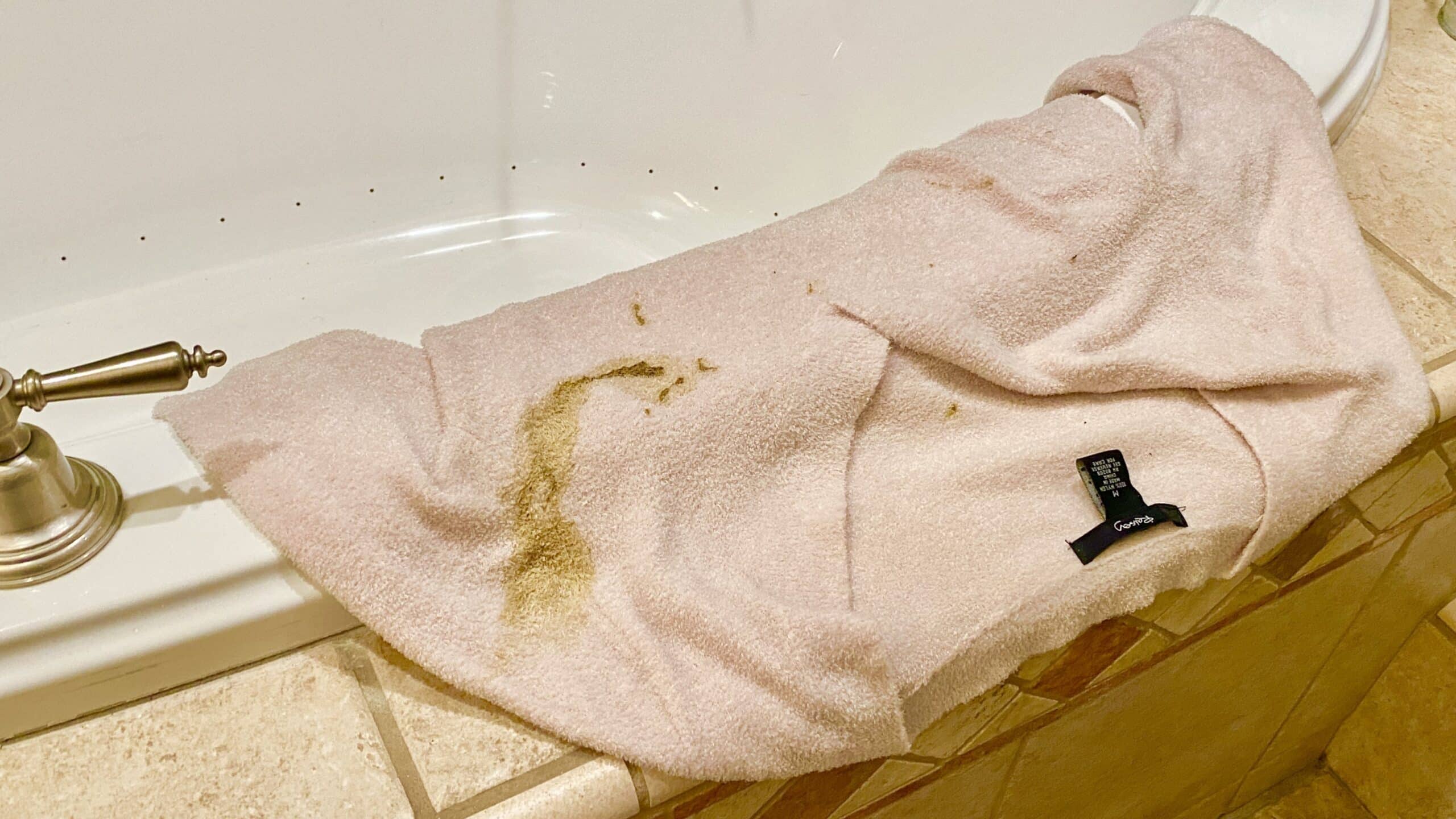
As soon as possible, rinse the fabric stain under cold running water to remove as much of the substance as possible. (Hot water can cook the proteins in the stain and further set it into the fibers.) Then spray the stain with my GIY Stain Spray, which is a 1:1 solution of Sal Suds and water. If the fabric is white or very light, sprinkle it with an oxygen bleach made of sodium percarbonate. Let that sit for 10 minutes, and then run it under running water again while rubbing the fabric against itself. Repeat the spray as needed, and then fully launder the item.
Removing pet smells from carpet and other surfaces
Usually it is our soft surfaces that harbor the sources of pet smells. Carpets, couches, pillows, and other upholstered furnishings need regular cleaning. For small items, start by tossing them in the no-heat cycle of your dryer. This will remove dust, dander, and fur which can cause mustiness. For carpets and large upholstered items, vacuum them thoroughly. Use all those myriad mysterious attachments to get in all the nooks and crannies.
Then, to freshen general pet mustiness in carpets, use baking soda. If you’d like, you can scent the baking soda by adding a few drops of an essential oil to 2 c. (240 mL) of baking soda. Toss with a fork, then add baking soda to a large spice jar. Sprinkle the carpet thoroughly. With a broom, brush the baking soda into the carpet and let sit for 10 minutes. Then vacuum out thoroughly using a vacuum with a HEPA filter.
For pee smells, and to deter recurring peeing on carpet, I use an enzymatic cleaner, which relies on proteins to breakdown the components in urine. I use one that does not have added fragrance. Spray the area thoroughly with the enzymatic cleaner and then let it air dry.
Dealing with pet hair
Pet hair has a magical ability to show up on every surface and every room. It floats, it clings, it weaves itself into fibers.
The best way to start eliminating shed hair in your home is with brushing your pet. Regularly grooming your furry friends catches their fur before it drops off their bodies and can greatly reduce the amount of fur that ends up on your floors, clothes, and furniture. Brushing your pet outdoors or over a towel can help reduce the spread of hair. I found some great tips on choosing a brush at the American Kennel Club’s article here.
Further tips for eliminating shed hair are similar to the 22 strategies for dealing with dust. Toss smaller soft furnishings into the no-heat setting on your dryer. Vacuum all surfaces often. Use fresh air filters on your HVAC system with a MERV rating above 13.
Here are a few more tricks I’ve found to help stay ahead of the fur storm.
Eliminating pet hair from your clothing
Add ½ c. (120 mL) vinegar to the fabric softener compartment of an HE washer to loosen pet fur from clothing during the wash cycle. Toss a microfiber cloth into the dryer to catch the fur. Using a reusable or washable lint roller can be a great on-the-go option.
On your furniture
Use your vacuum’s attachments regularly to remove hair and dander from upholstery, especially what’s gotten tucked into the corners and nooks and crannies.
Toss smaller items like pillows and blankets into the dryer on no-heat. Consider placing washable blankets or pet beds on furniture which helps protect furniture and makes clean-up that much easier.
There are a number of pet hair removers on the market. In talking to my colleagues, it seems that different ones work well on different surfaces and for different kinds of hair, so it might take some trial and error to find the one that works best for you. Here’s a place to start: The 11 Best Pet Hair Removers.
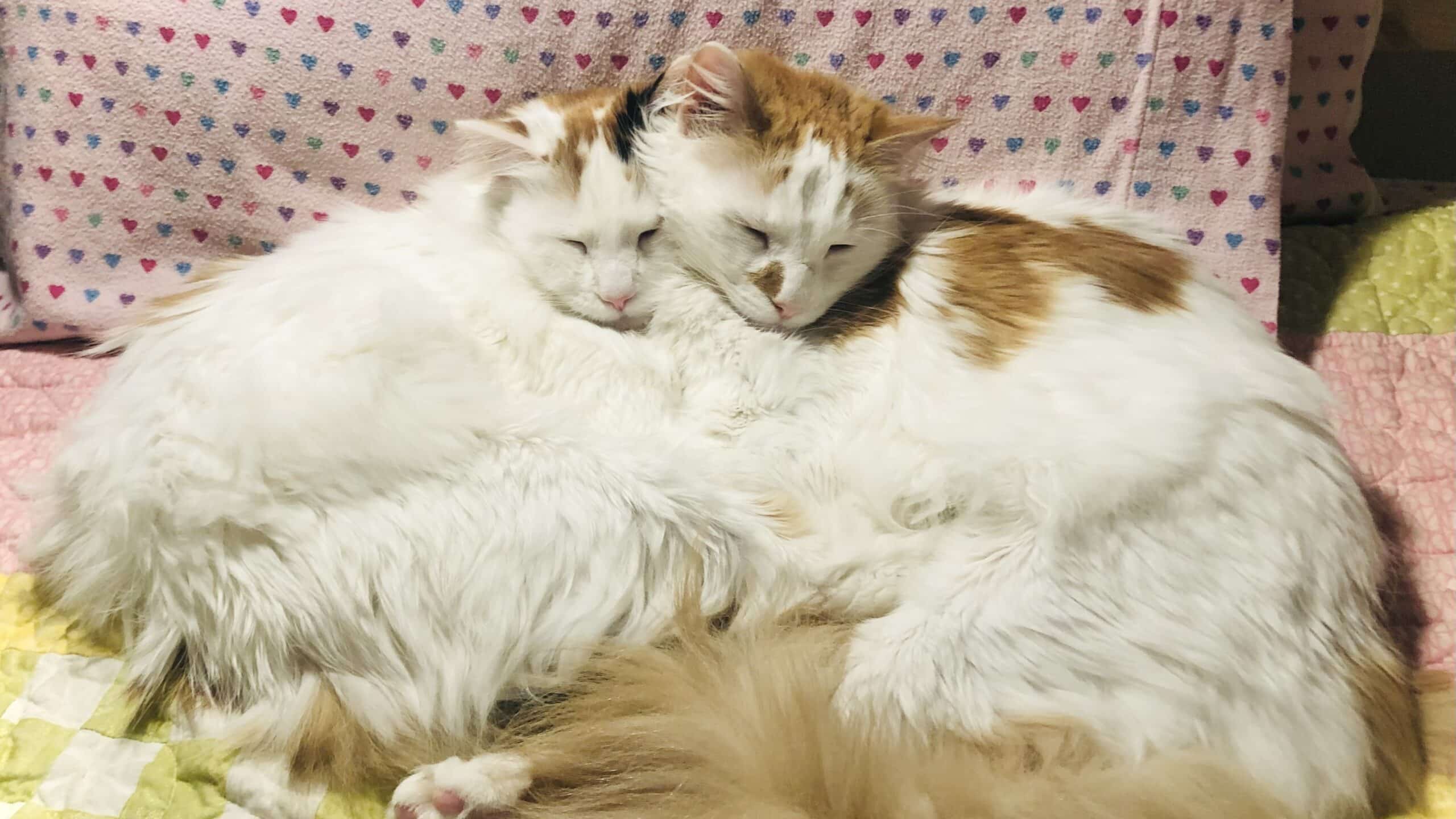
Spot cleaning pet smudges on upholstered furniture
The rule in our house is that dogs are allowed on the outdoor furniture, but not the indoor. Cats are allowed on any furniture except the kitchen counter and table. And they shouldn’t scratch anything other than the (many) specified scratching posts. The dogs heed the rules far more than the cats. So when your pets leave their marks on your furniture, here are some remedies;
- Machine washing: If the smudges are on something machine washable, like a pillow cover or blanket, you can throw them in the laundry using the method above..
- Spot Cleaning: In a bowl or bucket, add a small squirt (roughly 1 tsp. [5 mL]) Dr. Bronner’s Castile Magic Soap or a few drops (roughly ½ tsp. [2.5 mL]) Dr. Bronner’s Sal Suds to a quart of water. Dip the cloth in and dab at the stain. Repeat until the stain is lifted.
- Full upholstery cleaning: When a full deep cleaning is necessary, use an upholstery cleaner machine or the upholstery attachments on a carpet cleaner.
- Drying: Thorough drying is important as damp fabrics can foster the growth of microbes. Use a box fan, ceiling fan, or if the weather is not humid and the item is portable, the sun.
Glass cleaning
My front windows have nose prints and my back windows have paw prints. My animals are the number one way my windows get dirty.
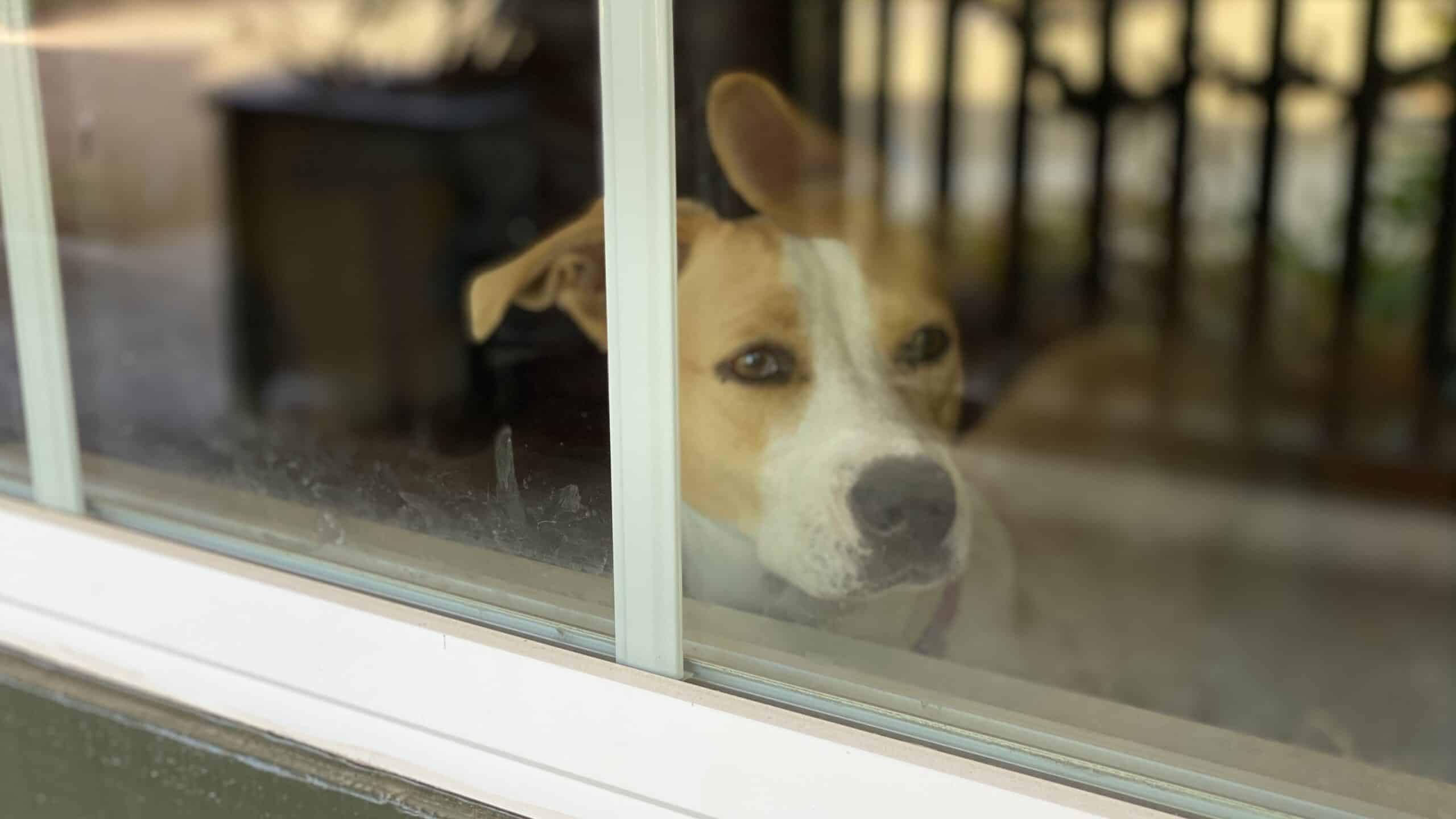
Combine water and distilled white vinegar in equal amounts in a spray bottle. Spray the windows and squeegee or wipe with a lint-free absorbent cloth. If windows have built up grime, wash with the GIY All-Purpose Spray first, and follow up with the vinegar solution.
For more details on glass cleaning, check out my article on cleaning windows and mirrors.
Deter unwanted chewing with a GIY No-Chew Spray
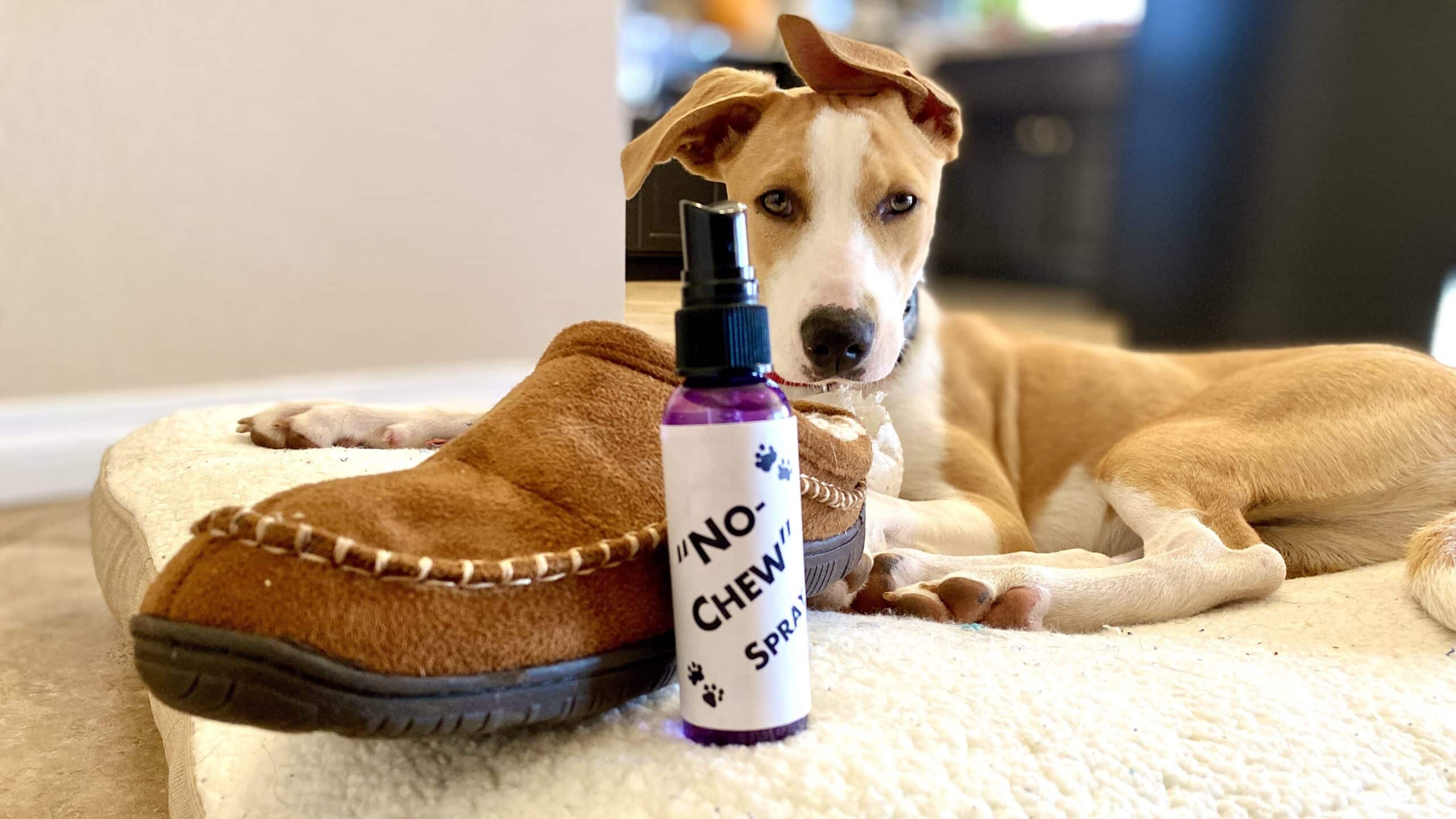
Sadie confined her chewing to shoes we were foolish enough to leave accessible to her. We learned to put those away. Layla, who is still a puppy, prefers to chew on windowsills and sprinklers, which are much harder to hide. I came up with this GIY No-Chew Spray to deter such behavior.
The savvy reader will recognize that I used a Dr. Bronner’s Organic Hand Sanitizer bottle for this spray. I filled it with:
- 2 parts distilled white vinegar
- 1 part apple cider vinegar
Spot test this on any light surfaces to check for discoloration.
To use the No-Chew Spray, spray the objects as needed. I have also misted my houseplants with Dr. Bronner’s Organic Lavender Hand Sanitizer to discourage my cats from nibbling on them.
What pet topics did I miss?
Give me 10 minutes of conversation, and I’m bound to tell you at least one pet anecdote. They are my constant distractions as I work from home. Sometimes I even head to the library just to be able to focus without them.
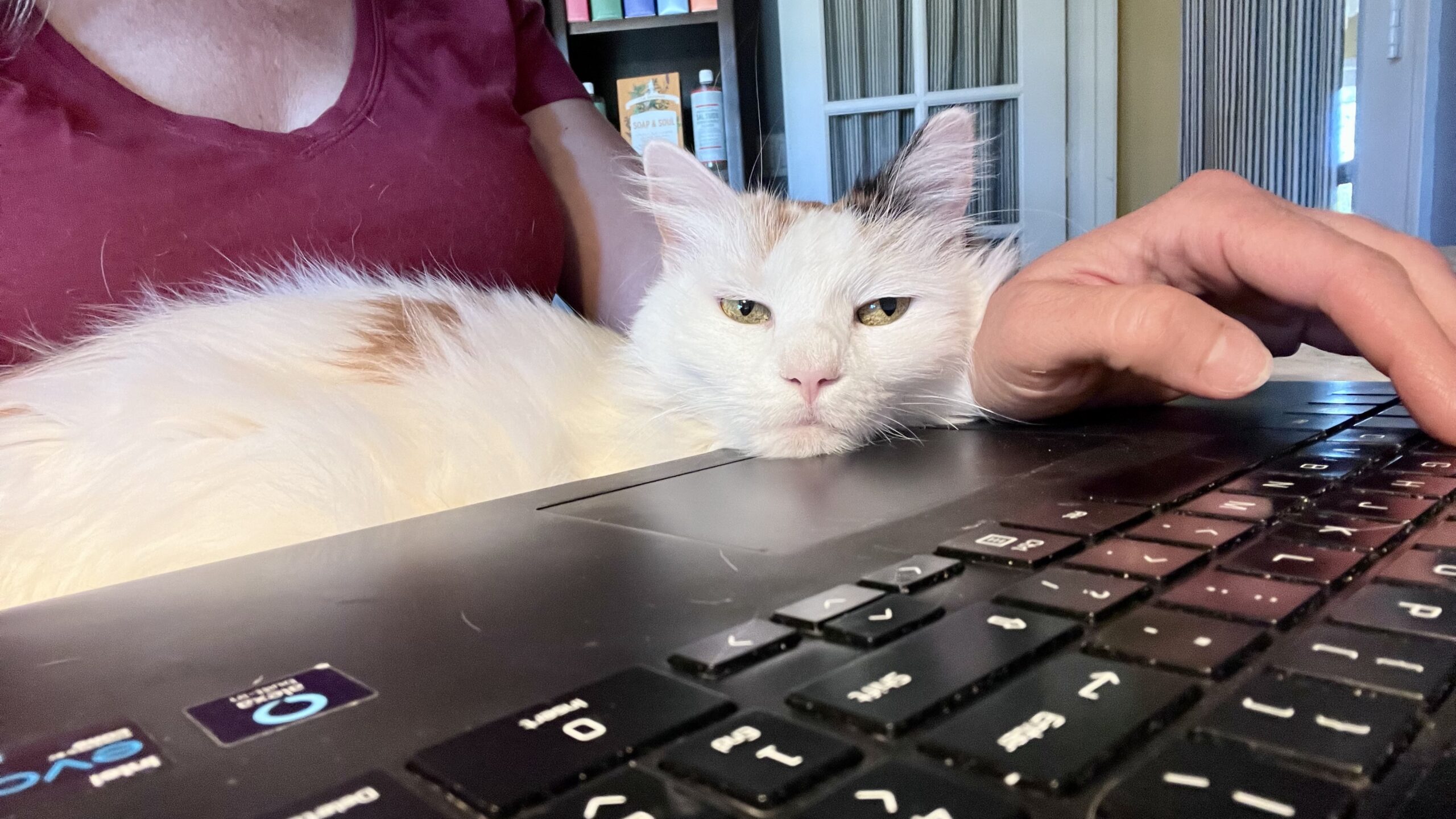
Things would certainly be a lot easier if our companions had opposable thumbs and could bathe themselves or scoop their own messes, but alas…they must rely on us. The least we can do is help them out in return for their unwavering loyalty, goofy grins, and the occasional zoomie explosion that reminds us why we love them so much.
I hope this guide has been helpful to you and has given you a few new tools to care for your pets. I tried to capture everything I’ve learned over the years but as always, if you have further questions, I will be happy to answer them in the comment section.
Further reading:
Sal Suds cleaner shows >60% biodegradation after 28 days per ISO 14593.

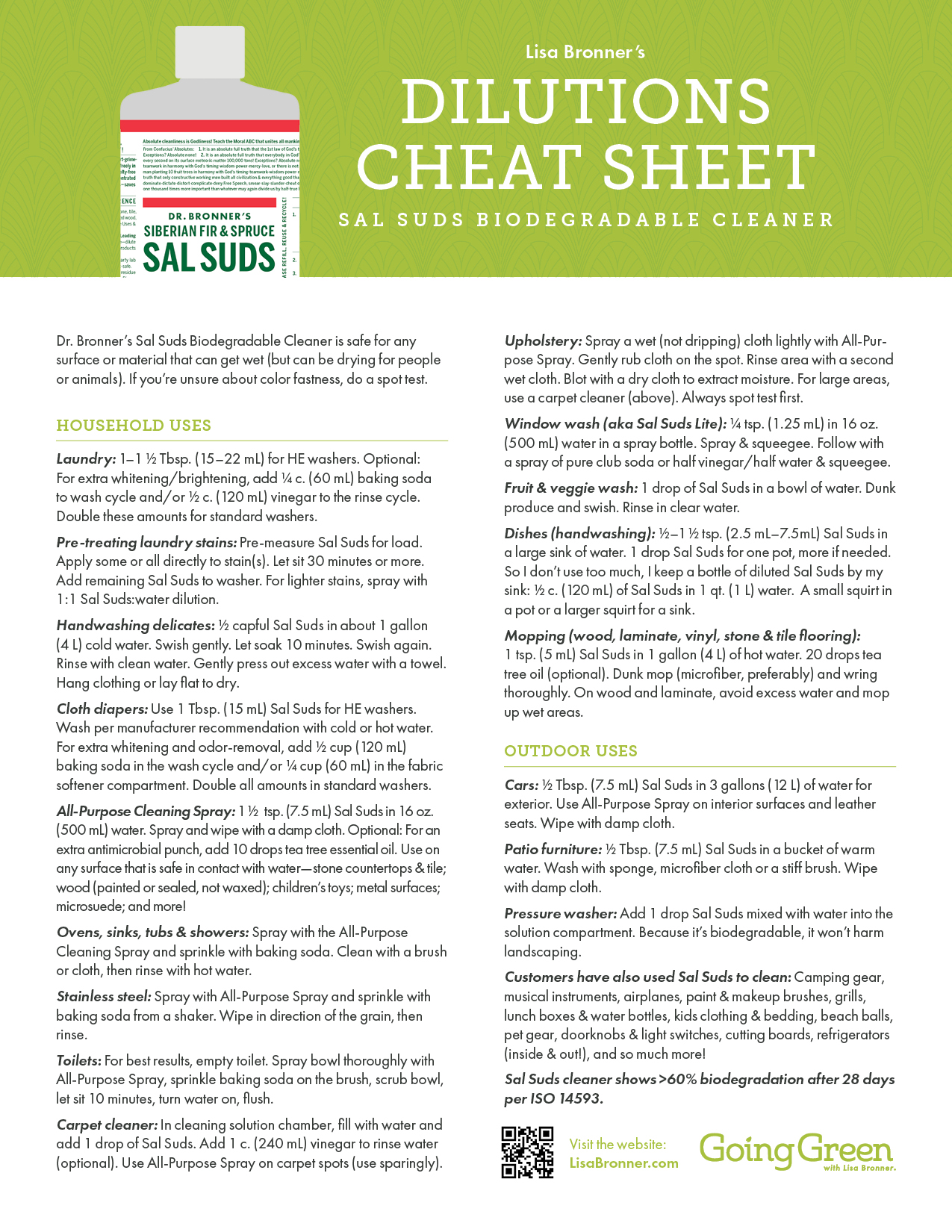
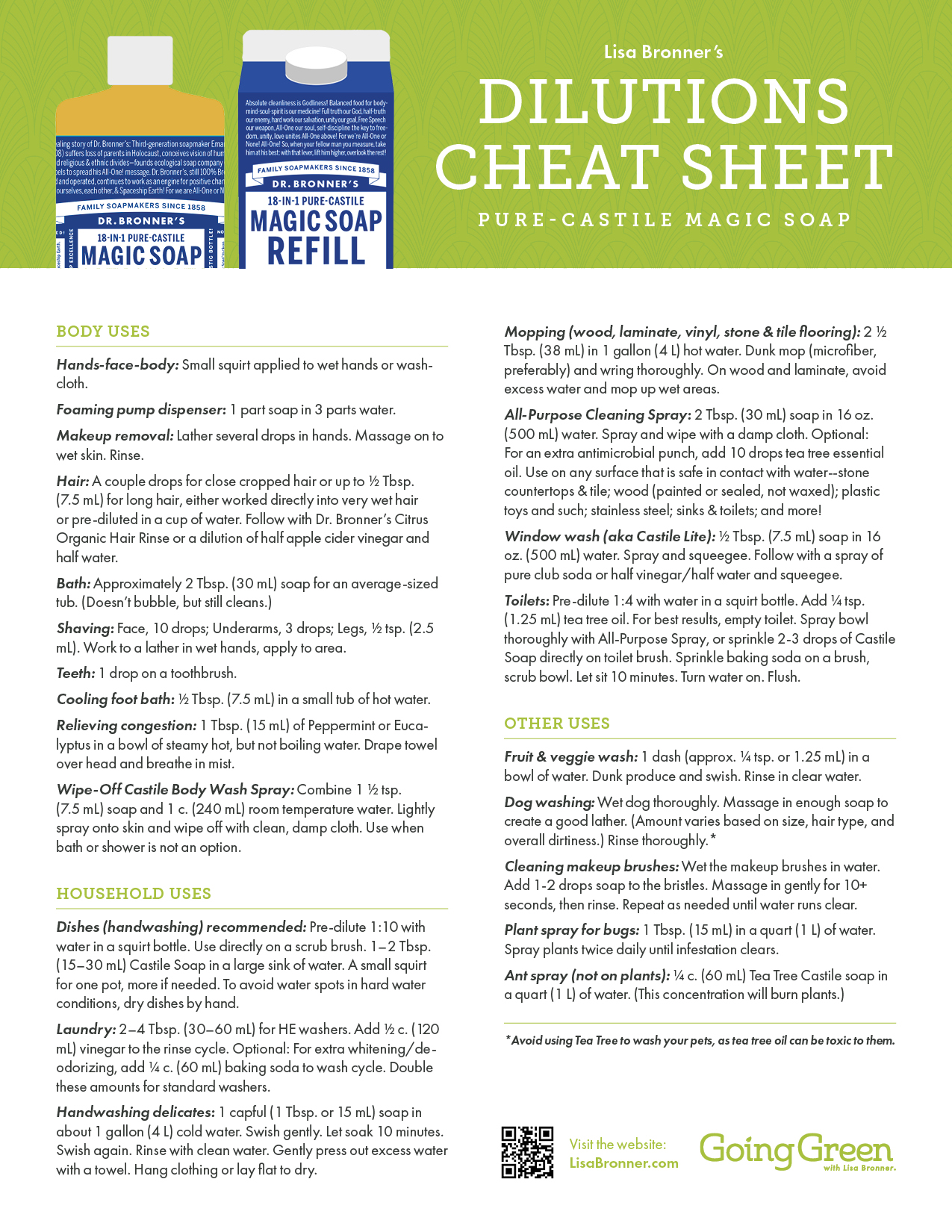
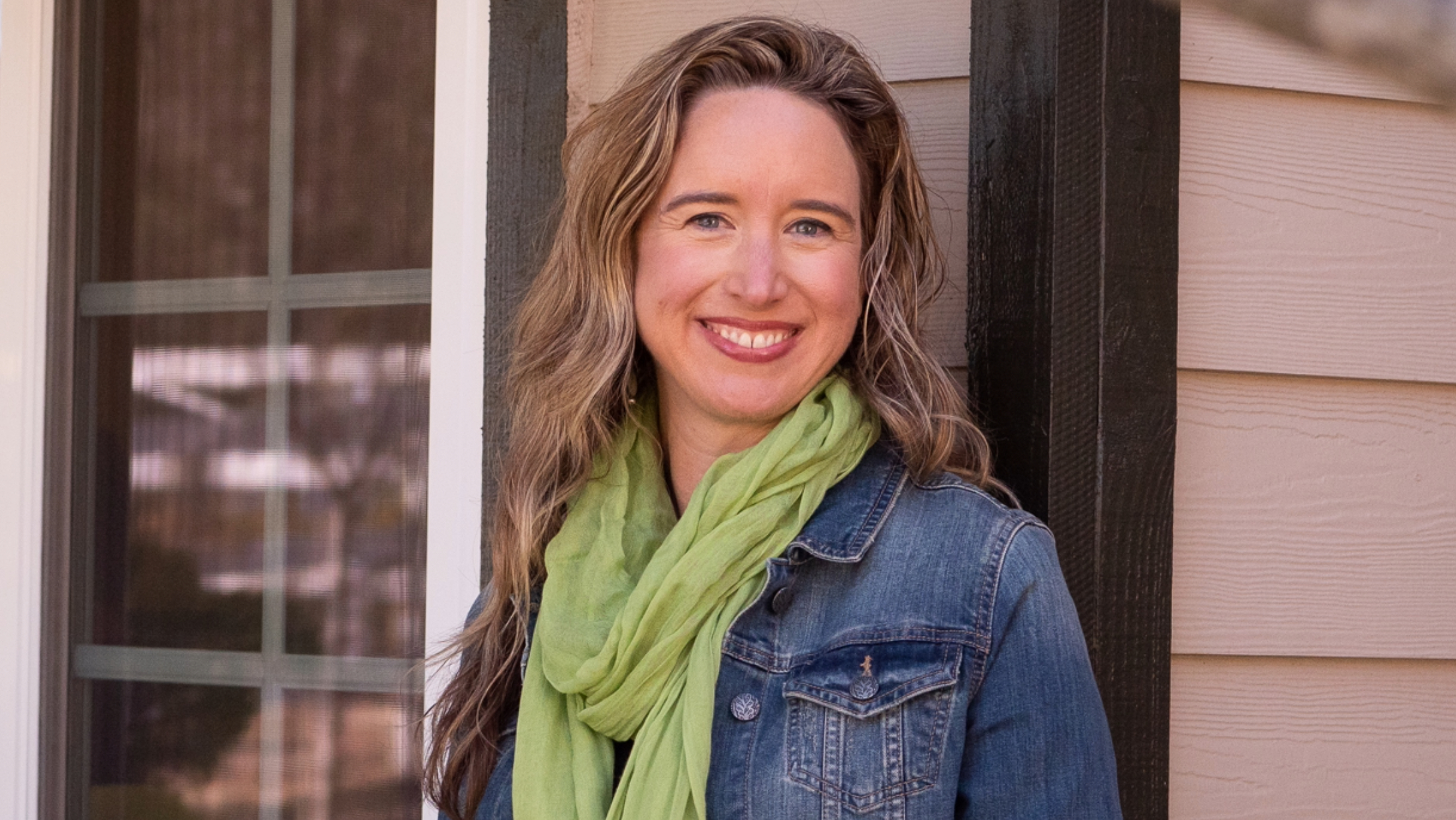
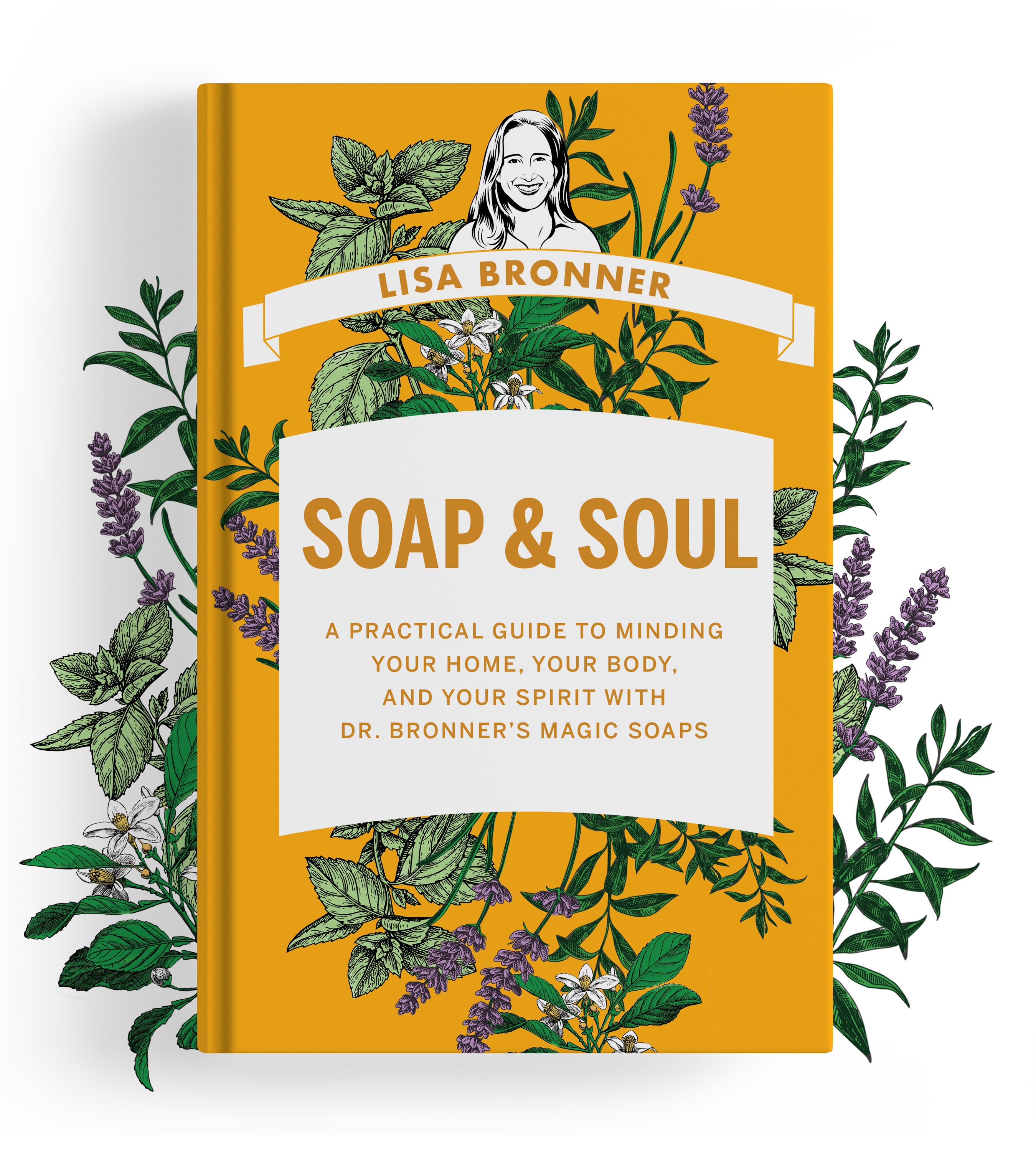
Will the DIY spray remove the cat pee smell from surfaces? We travel with our cat in a motor home, and when he gets a UTI, he will pee on whatever is convenient. I just can’t banish that smell which permeates the entire motor home. When I get home after the trip we’re on now, I will get my black light out!
Hi Kathy – My heart goes out to you and your kitty. I had a cat that was prone to UTIs, and it was just heartrending when he had an episode. The key thing is to extract as much of the liquid as possible as soon as you can by using microfiber cloths. Put them over the wetness and step on it to pull out any moisture. Keep replacing with dry cloths until you can’t pull any more wetness out. Then use the Sal Suds All Purpose Spray to wash the surface. (1/2 Tbsp. Sal Suds in 2 cups water). Spray and scrub with a damp cloth. Then scrub again with a wet cloth to rinse the area. Then, I use an enzymatic cleaner with no fragrance. The brand Anti-Icky-Poo has been working well for me. The enzymes break down the proteins in the urine. You spray the surface thoroughly and let it air dry. Spot check this on an inconspicuous spot of fabric beforehand. Good luck!
Thank you for this article! Going to come back to it often.
I would love any advice you have for deep cleaning litter boxes. I try to deep clean mine monthly but sometimes wait longer. I clean with a spray mixture of unscented/baby Castile soap and distilled water b/c I don’t want any scent to be a bother. But, now I’m wondering if something stronger like Sal Suds would be better. I did notice that cleaning and then leaving to dry in the hot sun helped take care of odors better than hand drying and bringing inside immediately. Anyway – open to other takes!
Hi Erica – Washing with Sal Suds is an excellent option, and it is very clean rinsing so no scent will adhere to the litter box. As you’ve discovered, the sun is an excellent deodorizer. I use it regularly for this purpose. (Also works on wood cutting boards that smell like onions!) Sprinkling the litterbox with baking soda, letting it sit for an hour or so, and then dumping/wiping it out also helps.
Question: I have used Dr. Bronner’s castile soap for my dog for many years. I was recently taken to task by a friend who said I should be using a ph-balanced pet shampoo for my dog and further, that the ph of your soap is much too alkaline for dogs. I’ve been happy with the condition of my dog’s coat (maltipoo), lack of chemicals, easy of use and reasonable cost. I have not noted any problems so I’m not likely to change, but I would like to respond to my friend. Good article, thanks.
Hi Carolyn – It sounds like the best evidence is how healthy and nice your pup’s coat is! But to address your friend’s concern, often times when people hear the word “soap,” they assume a pH up around 11, and there indeed are soaps with a pH that high. However, Dr. Bronner’s Magic Soap has a much lower pH in the mid-9s, and then when you dilute with water (neutral pH), the pH really comes down to near neutral. I hope these points help your conversation!
Although I have no pets, I thoroughly enjoyed your pet stories. My daughter and her family have a sweet cat that I get to visit, and there is a neighbor cat who occasionally comes into my place through the back door. Unfortunately, this visiting cat likes to scratch my sofa, and I do not want her to do that. When she does, I put her back outside, but I hate having to do that. Will the “no chew” spray work as a no “scratch” spray? I know there are sprays for sale, but one that I make would be so much more reasonable.
Hi Valerie – Unfortunately, the no-chew spray is unlikely to deter scratching, but here are some ideas that I’ve found work in my house: Putting scratching posts next to the object they like to scratch. Some cats like to scratch vertically (fronts of sofas, sides of chairs), so use a vertical scratching post. Some cats like to scratch horizontally (tops of sofas, seats of chairs), so use a flat scratching pad. I sprinkle the scratching posts/pads liberally with dried catnip in order to endear the cat to the proper place to scratch. Hope that helps!
I love the usefulness and thoroughness of this article. Sometimes when caregiving a chronically ill family member I become overwhelmed with the household decisions and chores of the day. This article or series of subjects and guidance is extremely helpful to me. Also, as others with family members with chronic illness of unknown etiology may know, it is quite important not to add a toxic burden to their loved one’s situation. That is something I don’t worry about with these Dr Bronner products. I’m quite grateful for the products and the guidance. It is a blessing.
Thank you for the kind words, Sonia. I’m sorry to hear about the health challenges your family is facing and glad this could be of some help.